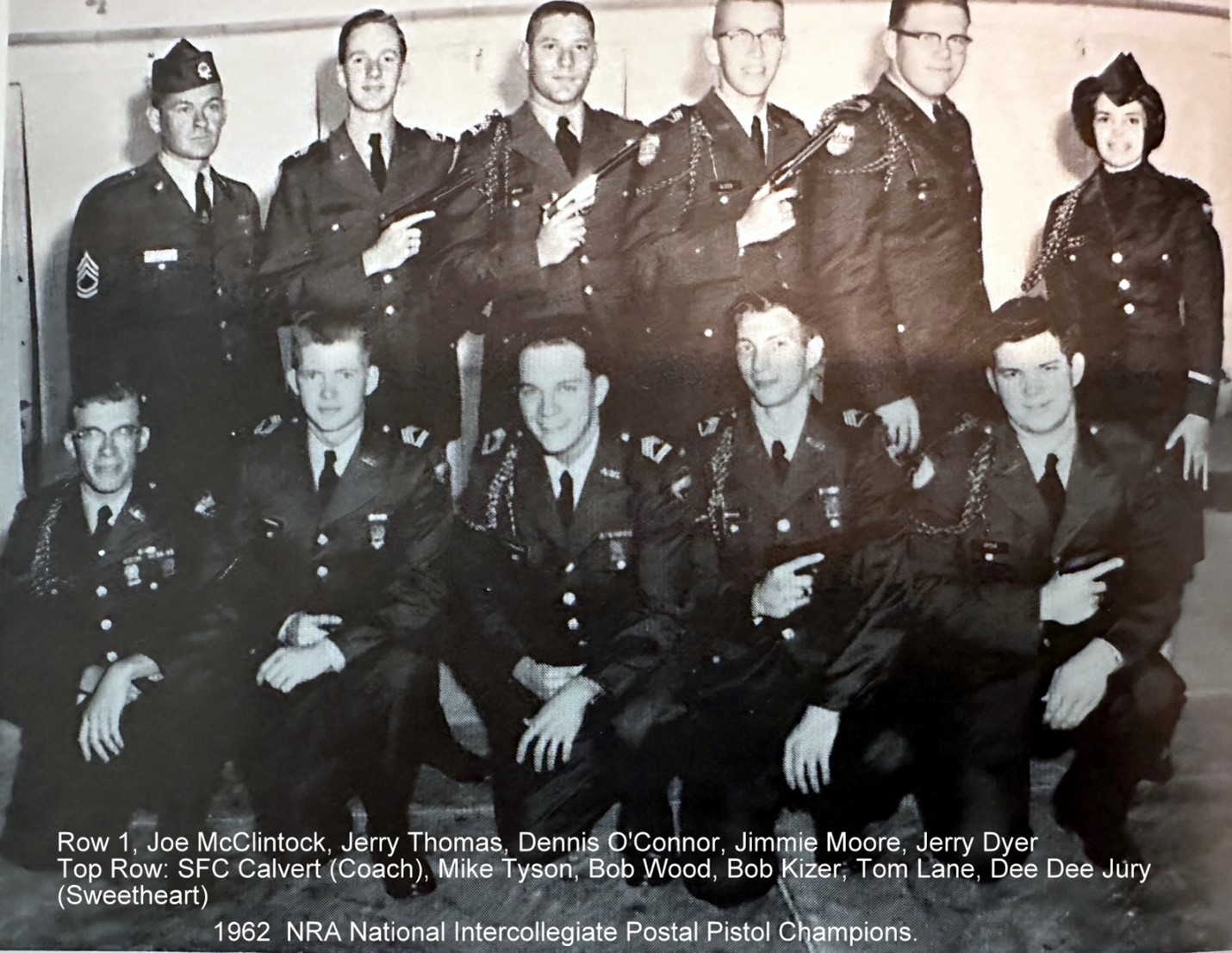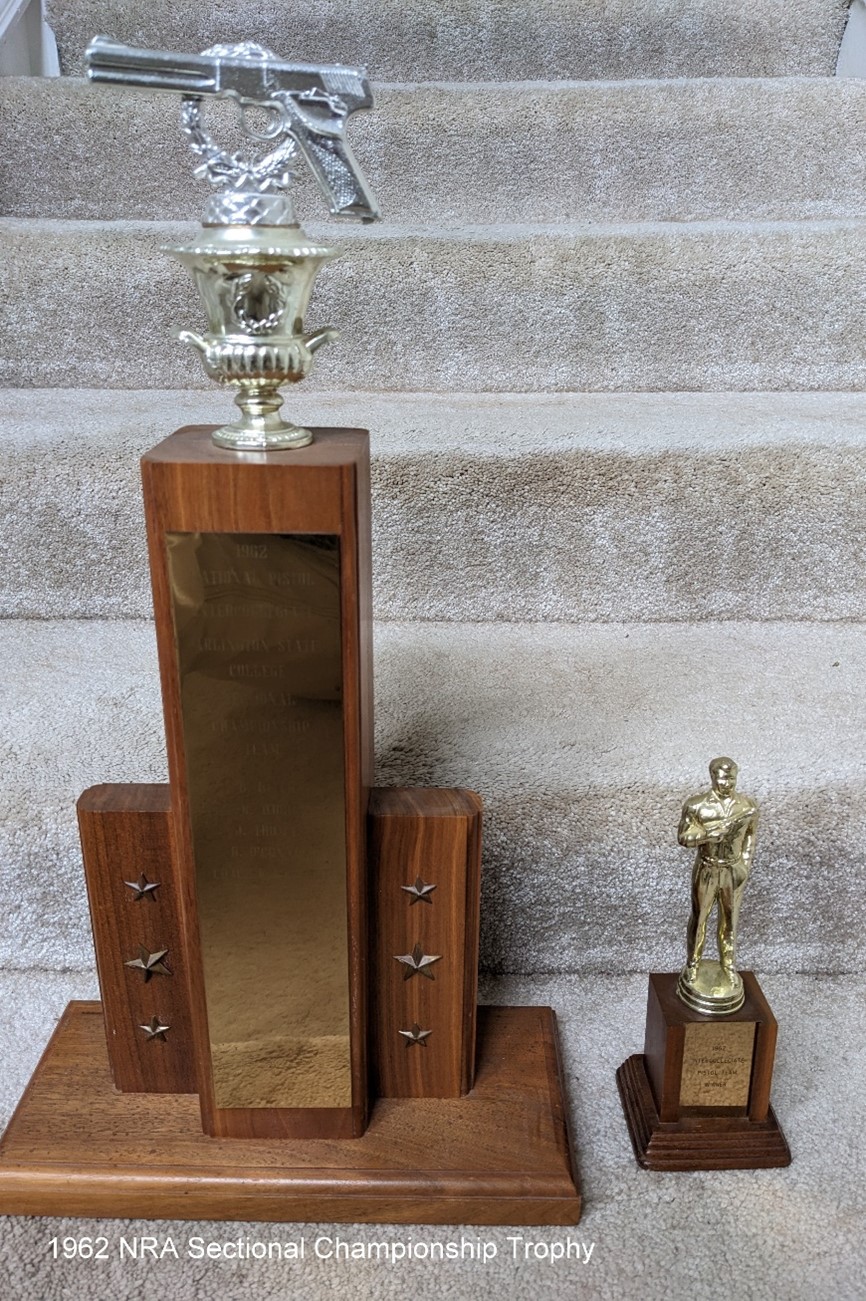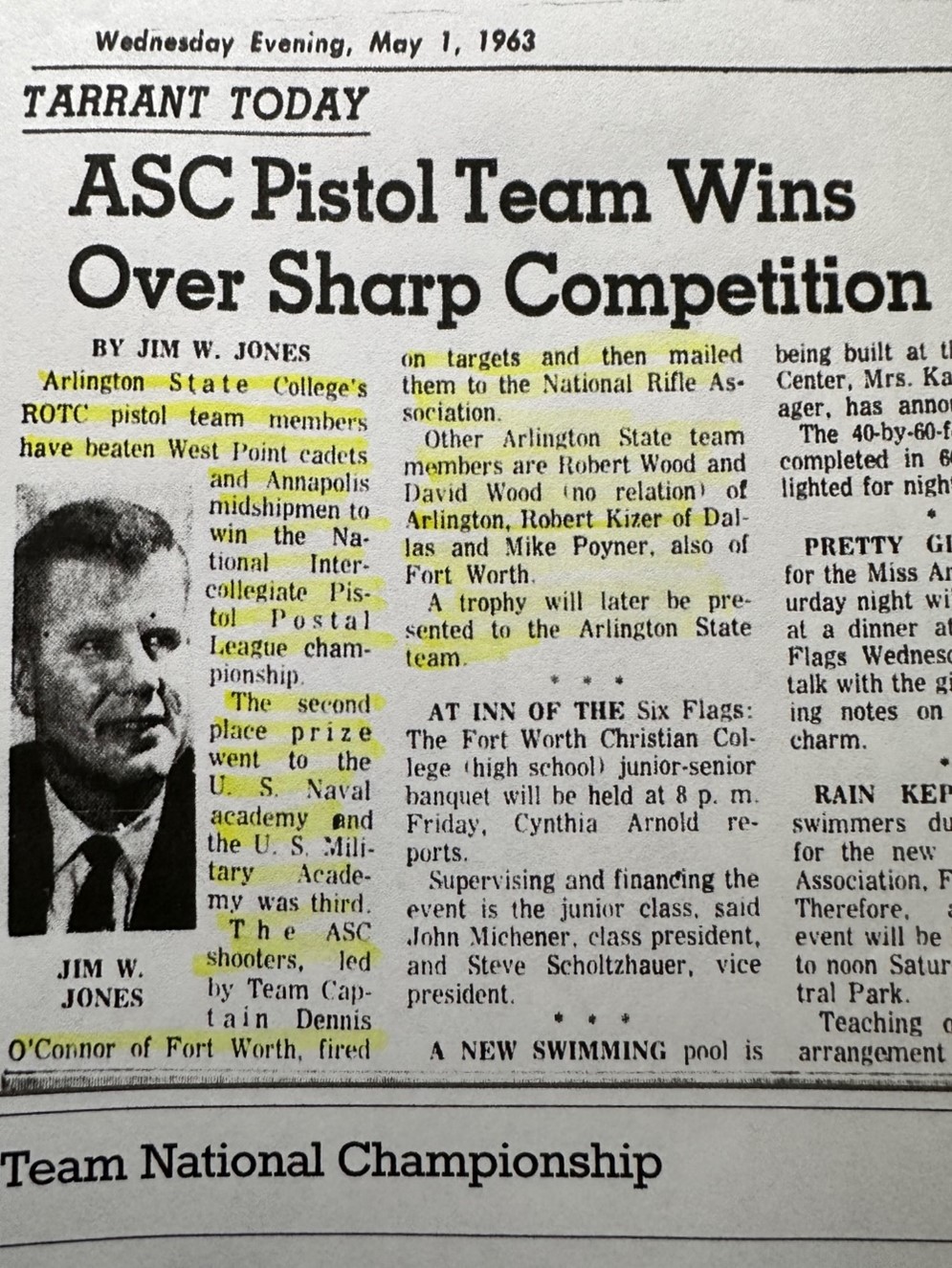|
- Home
- History
- Organizations
- Pistol Team
Arlington State College Pistol Team: Remembering the Amazing 1961–1963 Seasons
Submitted: October 2023
By: Dennis O’Connor ('64)
In the fall semester of 1961, the Arlington State College (ASC) Corps of Cadets had grown to approximately 600 members. At that time, Arlington State had recently become a four-year degree-granting institution, part of the Texas A&M system. Rapid economic growth in the DFW area and a growing emphasis on college education, particularly in technical and scientific fields (following the Soviet Union's launch of Sputnik in 1957), had led to a significant increase in Arlington State's student body. Due to this growth and the draft registration requirement for all young men aged 18 and over, the Corps of Cadets had also experienced rapid expansion.
Sponsored activities available in team sports for cadets were the Rifle Team and the Sam Houston Rifles Drill team. With a larger number of cadets, there was a need for another competitive team activity to engage more of them. Sergeant First Class (SFC) Ray Calvert was newly assigned to the cadre of the ASC ROTC detachment. SFC Calvert had competitive pistol shooting experience and was assigned as the coach and developer of the new Pistol Team. Funding was obtained to acquire High Standard .22 caliber target pistols, ammunition, and other necessary equipment.
At that time, the rifle range, cadet armory, and quartermaster operations were located under the school library building (now called College Hall) on the south side of the street from the E.H. Hereford Student Center. ROTC offices now occupy the entire space, but the rifle range no longer exists. At the time, it was a topic of amusement that ASC students in the library above had to study while rifle practice or competition was taking place below them—with the sounds of gunfire echoing around the library. These poor library students were about to face further challenges when pistol practices and competitions were added to the library's cacophony (unlike the single-spaced shots of rifle shooters, pistol competitions involved rapid and timed firing stages by multiple guns simultaneously).
SFC Calvert had to add facilities to the rifle range to accommodate pistol practice and competition. He constructed frames to hold the targets, which could be turned towards or away from the shooter during the timed firing stages using a system of pulleys and levers. Tables were also needed for shooters to place guns, spotting scopes, and other items at the firing lines. These tables needed to be movable to clear the way during rifle competitions.
Notices recruiting shooters for the team were posted on the bulletin board, and approximately ten prospective members received coaching from SFC Calvert in the rules of what was then called Bullseye pistol shooting and in the techniques of accurately firing a match pistol. This type of shooting involved competitors standing at the firing line, 50 feet from the target, with their bodies at approximately a 45-degree angle to the line. The shooting arm extended the pistol toward the target, aligning the sights for precise aiming, and carefully squeezing the trigger to minimize disruption to the bullet's point of impact.
Competition for Intercollegiate Pistol involved the three stages of fire of the National Match Course. The Slow Fire stage comprised ten rounds fired over a ten-minute time period. The Timed Fire stage had two strings of five rounds each, with a 20-second time limit for each string of shots on a target. Rapid Fire consisted of two strings of five rounds each, with a 10-second time limit for each 5-shot string. The paper targets had a circle with a small center ring and concentric rings. Targets for timed and rapid fire had a larger bullseye than the slow fire target. The center ring counted as 10 points, with each ring farther from the center counting fewer points (9, 8, 7, 6, etc.). Points were awarded based on which ring the round hit, with a maximum score of 300 for the total of 30 rounds fired.
After the initial formation of the Pistol Team, certain traditions, similar to those held by the Sam Houston Rifles and the Rifle Team, needed to be established. A team sweetheart was elected, and it was decided that the team's identifying fourragere (a braided cord worn on the shoulder) would be the red and silver one used by the rifle team but worn on the right shoulder.
Practice sessions were held after classes. Once team members demonstrated proficiency and proper safe handling of the pistols, they were granted access to the range, guns, and ammunition without coaches present, at specified times that did not conflict with rifle practice times. Some members had prior experience in the sport and effectively coached less experienced shooters. Robert Wood had prior experience and was a former enlisted Army MP, while Robert Kizer was a seasoned competitive shooter in civilian competitions. Both proved to be helpful as student coaches, and other team members were diligent learners who quickly gained competence.
SFC Calvert arranged "shoulder-to-shoulder" matches with teams from other schools, both at home and away, as well as "postal" matches in which teams fired on certified targets and mailed them to judges for scoring. Shooting against competitors standing on the same firing line in shoulder-to-shoulder fashion is more difficult than firing in postal matches or against your own teammates because of the increased mental pressure that affects the small motor nerves and muscles needed to properly control sight alignment and shot release of a match target pistol and was great experience for matches to come in the future. Teams like Texas A & M, The Dallas Revolver and Gun Club, and others visited ASC for matches, contributing to ASC shooters' experience, focus, and proficiency.
SFC Calvert scheduled a major shoulder-to-shoulder match for March 3, 1962, when ASC hosted the Southwest Sectional meet with four schools in attendance. ASC claimed first place as a team, with the Air Force Academy in second place and Texas A&M in third. ASC also secured the first four individual places, with Bob Kizer achieving the highest individual score of 290.
On March 31st, the team participated in a postal match that included competitors from all over the United States, including the U.S Military Academy, U.S. Naval Academy, the Coast Guard Academy, Rutgers University, and other schools, all of which were larger and had much longer traditions than ASC. In late April, it was announced that ASC had secured first place in the NRA National Intercollegiate Postal Match, a national championship. The second team from ASC secured 11th place, with Bob Kizer ranking fifth individually and Bob Wood ninth.
To summarize the fall semester of 1961, the team had won 19 out of 22 Postal matches, including matches against an FBI team, Naval Academy, U.S. Coast Guard Academy, and others. Over the fall and spring semesters, they also won all of their shoulder-to-shoulder matches, except for an outdoor match at the Dallas Revolver and Gun Club. These achievements added to the major successes in the NRA Southwest Sectional and the National Intercollegiate Postal Pistol Match.

The First Place Team members in the NRA Intercollegiate Sectional Championship and the National Postal Pistol Championship were Jerry Thomas, Bob Wood, Bob Kizer and Dennis O’Connor.

1962/1963 Pistol Team

Based on their performance in competitions throughout the year, academic performance, and other criteria, the National Rifle Association named Bob Wood and Bob Kizer as first team Intercollegiate All-Americans, while Jerry Thomas received second-team recognition.
At the beginning of the 1962 Winter semester, most of the core members of the previous year's team returned and were more proficient. To the relief of library patrons, the range moved to a larger space in the basement of the new gymnasium building on the campus west of Cooper. By this time, Captain Bobby Joe Davis had secured approval from the Heraldic Institute for a new team fourragere, a black and silver one worn on the left shoulder.
Diligent practice and participation in more shoulder-to-shoulder matches, including those away at the Air Force Academy and the University of Oklahoma, as well as matches at ASC's home range against other schools, advanced the skill level of most shooters, especially those who were most committed to practicing on their own time. ASC also continued to compete against individual schools via postal matches.
Continuing the major match success, in March of the 1963 Spring semester, ASC again hosted and entered two teams into the NRA Sectional Matches. Both teams emerged victorious, with the University of Oklahoma Naval ROTC team placing third. Three ASC shooters (Bob Kizer, Bob Wood, and Dennis O’Connor) were high individual scorers. Bob Kizer was once again named to the First Team of All Americans, and Bob Wood earned a spot on the Second Team.
ASC shooters once more competed in the NRA National Postal Pistol Matches, held at the end of March. However, unlike the previous year's victory, the team placed second, narrowly losing to the Air Force Academy by only 11 points. In the individual match, Bob Kizer secured first place, and Dennis O’Connor placed eighth. Mike Poyner won the freshman category, and David Wood came in eighth. This performance by ASC was still impressive, given the nationwide competition.
During the Spring 1963 semester, Arlington State joined and competed in a national league of 12 teams in postal matches. When the final results were announced in late April, the team had won 11 out of 12 matches and claimed first place. The U.S. Naval Academy secured second place, and the U.S. Military Academy came in third. Michigan State University and Rutgers State University placed fourth and fifth, respectively.

After the Spring 1963 semester, members of the original group began to leave. Bob Wood and Jerry Thomas graduated, Bob Kizer transferred to the University of Houston, and the accomplishments to which they contributed were never replicated again. Although ASC continued fielding a pistol team for several years after the 1961-63 seasons, its composition changed from all ROTC members to include members of the general student population, including women.
The 1961–1963 team was unique in how quickly it went from non-existence to winning a national championship. It also dominated sectional shoulder-to-shoulder events against formidable, long-established programs at much larger universities in just under two years. The combination of having an experienced coach, two members with extensive prior competitive experience, and new shooters who practiced and acquired great skill rapidly produced winning results and an incomparable two years.